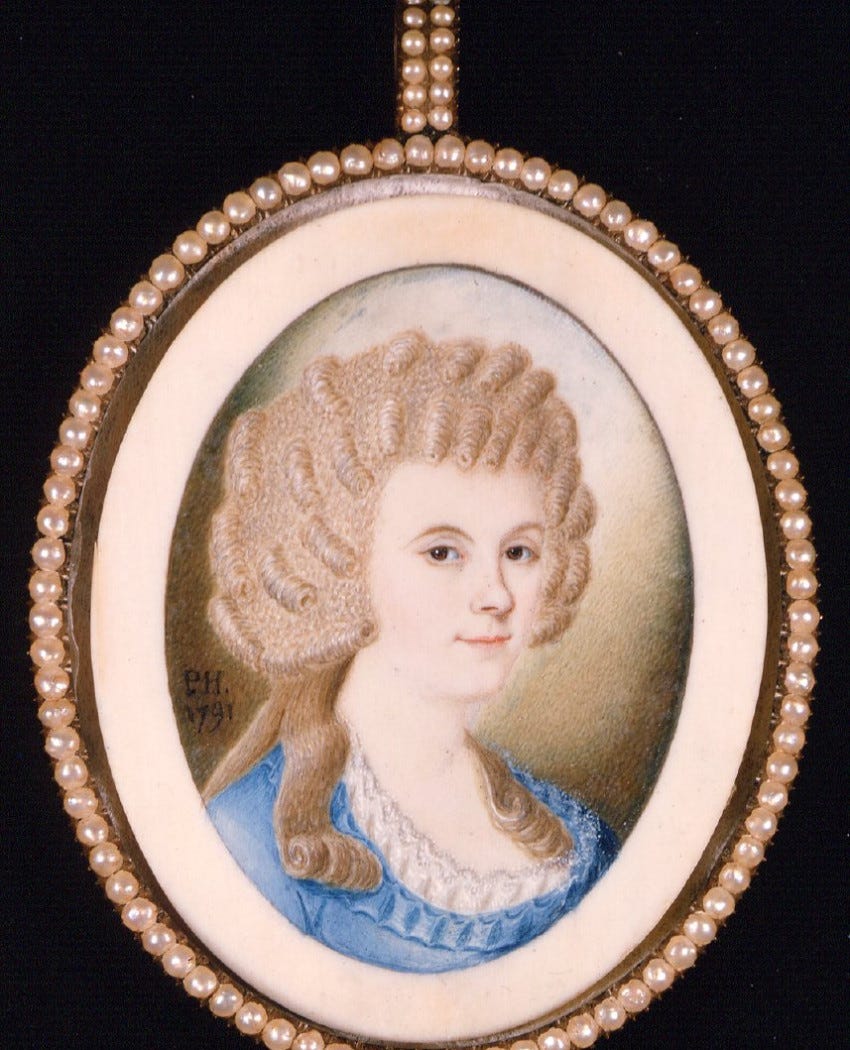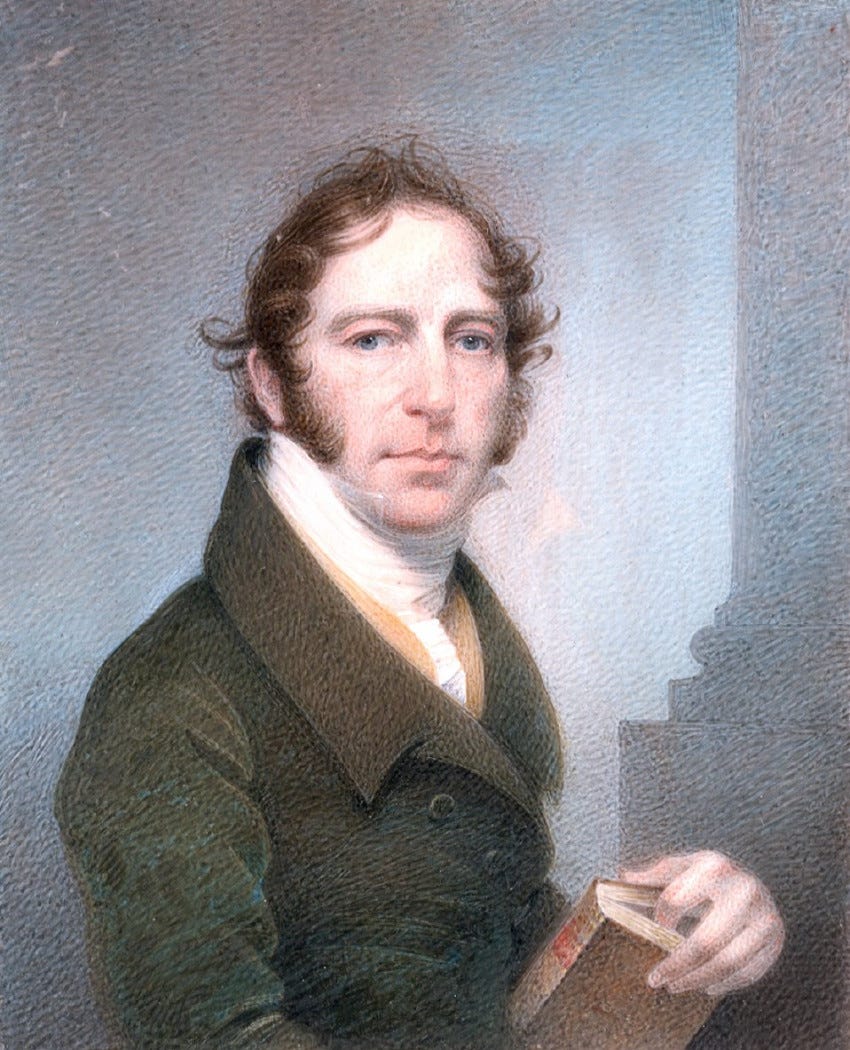Stepping into the dimly lit miniature room at the Gibbes Museum of Art in Charleston, South Carolina, takes me back to childhood. The 200 or so miniatures mounted on the walls and in the cabinet drawers remind me of the school pictures my friends and I traded every year. Both the custom-made watercolor-on-ivory portraits and our childhood color photographs on paper represent historical versions of modern-day digital selfies that we capture on our electronic devices.
Historic miniatures were meant for private use. Owners would keep them in their pockets, on their desk or bedside table, or maybe wear them like jewelry. They were also expensive, requiring both time and money to create. In contrast, 20th-century school pictures formed the basis for documenting a school year in “the annual.” Students were herded in and out of a make-shift photography studio (often located on a stage or at the back of a cafeteria) for a quick snap. The resulting images were traded like baseball cards that sometimes included a short note of affection on the back, “remember me always,” we’d write. Today we take and store so many pictures on our phones and computers that the phenomenon of holding a loved one’s image close has lost some of its magic.
Standing in the Gibbes Museum of Art’s miniature room I am immediately struck by all the pale faces, for they are all pale faces. Most of the sitters in the Gibbes’s collection hailed from Charleston, adding a layer of history that underscores their identity: most of these wealthy people were slaveholders. These are the faces of humans who valued themselves more than other humans. The people peering into the gallery owned other people, or benefitted financially from those who did, and society sanctioned the practice. Viewed this way, the room, which on the surface feels light and welcoming, serves as a reminder of the darkness of humanity. We can be so cruel to one another.
But even in darkness there is light. One miniature reminds us of humanity’s hopefulness, the name Grimke. Mary Moore Smith Grimke was the mother of the outspoken Grimke sisters Angelina and Sarah who became fierce 19th-century advocates for women’s rights and the abolition of slavery, despite their upbringing in a paternalistic, slaveholding family.

Knowing the identity of the people featured in the Gibbes’ miniature room taints the experience, but I can’t help but look. The miniatures are time capsules of the past. Not all of the people are beautiful, but many are. They are all dressed in finery, and the details can be delicious, especially those found on the women with their curls, hair pieces, ribbons, lace, floral adornments, and jewels. I especially love examples of bright orange coral jewelry. The fellows sometimes show flair too, but their self-expression is usually limited to their hair, be it long curly locks, muttonchops, beards, and the occasional mustache.
I love miniatures, and their larger-sized versions of paintings on canvas, because they depict people. I find humans infinitely fascinating, both living beings, as well as those immortalized on ivory, paper, canvas, digital screens, or any other medium. I can get lost in a face, and linger over a portrait as I take in all the details of an image, from buttons and lace to dimples and curls. I find miniatures especially charming, and often find myself transported to the sitter’s world. Who was this person? What were they like? Where was the painting created? In a parlor? In a studio? In a rented room? Was the sitter a traveler? What did they read? Did they play a musical instrument? For whom was the miniature painted? On and on.
While the sitters draw me in, I am also interested in the people who created the miniatures. Often the artist is unknown, or if identified by name their biographical details are sometimes absent. Many women were miniature painters. The practice was an acceptable pastime for wealthy females. For others, the pastime was a profession. A few men even traveled town to town selling their artistic skills to people willing to pay for the service. These traveling professionals were like magicians, creating something from nothing.
A portion of the Gibbes collection was created by Charleston artist Charles Fraser, seen in the self-portrait below. Fraser began his career as an attorney, but changed his profession to artist in 1818. In addition to miniatures, the museum owns his secretary (desk) and his account book, which give further insight and meaning into Fraser’s career, as well as miniature-making in general. For example, his account book lists his clients from 1818-1846, and includes prices for services rendered (on average $40-$60 per miniature). Occasionally he added notes. On April 27, 1838, for example, he painted “Miss Hart.” Under her name he noted in red ink: “memorable night.” Interesting. I wonder what happened that night!

Fraser may have used his self-portrait as a sample to show potential clients. His painting captures traditional portrait elements like the column and book, indicating the sitter is cultured and literate. He also demonstrates his artistic skills, such as capturing different textures and nuanced features like the folds of his velvety coat, and the wispy curls framing his face. His image evokes a feeling of movement and immediacy by turning his head towards the viewer as if he has been interrupted. His direct gaze alludes to this specific moment in time. Here he’s ever-so-briefly pausing from his book, which he has marked with his finger, to address his interloper, “Yes,” he says. “May I help you?”
The last wall case in the gallery presents early examples of a new medium: photography. In 1839, daguerreotypes were developed by using a chemical process that involved silver-coated copper metal plates. Rather than a painted likeness, this new form depicted a more life-like image. By mid-century this technology quickly took hold, and painted miniatures decreased in production throughout the 19th century. Many people enthusiastically embraced the new technology, like Elizabeth Barrett Browning who said in 1843 that she “would rather have such a memorial of one I dearly loved, than the noblest Artist’s work ever produced.” However, others bemoaned the invention, like her brothers who “cry out against [it] so vehemently.” (As quoted in Mike Weaver, ed., The Art of Photography, 1839-1989, Yale University Press, 1989)
Miniatures continued to be made into the 20th century, but daguerreotypes and other forms of photography replaced the practice. The reduction in time to create an image also reduced costs, which afforded many more people the opportunity to own a portrait. Photography also documented darker elements of society, particularly slavery. Rather than the absence of enslaved people depicted in the more expensive and time-consuming medium of painted miniatures, the new medium allowed for a quick and less expensive means to capture the likeness of some enslaved servants. Photography was also used to capture an image of a deceased loved one, especially children. While there is no way to know for certain if the child is sleeping or deceased in the central image of this case, the practice of photographing the deceased was common.
I always recommend an in-person visit to a museum, but you don’t have to wait for a trip to Charleston to see selections from the Gibbes Museum of Art’s more than 600 miniatures—check out their website. This wonderful digital resource has lots of information about their collection, as well as a video about the making of miniatures, a fully digitized view of Charles Frasier’s account book, and more. https://www.gibbesmuseum.org/miniatures/collection/











Fabulous, Tania, as always well written and interesting on a subject that I didn't think would be so. Nice job in tying miniatures to our school postage stamp sized headshots! Coincidentally, my husband found his collection from over his school years and it has been fascinating to see that his expressions of mischief remained consistent throughout even as his face matured.
Thanks! Wish I'd had this last week. I was in the Uffizi museum in Florence. To escape the crowds, I stepped into an empty side room - miniatures hung on the walls, in cabinets, everywhere. I found them eerie and fascinating but there wasn't interpretation - I needed this!